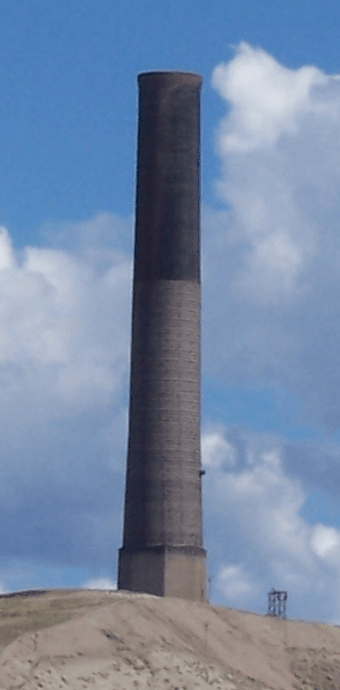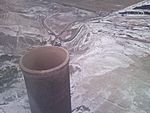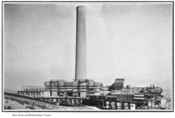Anaconda Smelter Stack facts for kids
Quick facts for kids |
|
|
Anaconda Copper Mining Company Smoke Stack
|
|

Northwest side
|
|
| Location | Anaconda, Montana |
|---|---|
| Nearest city | Butte, Montana |
| Built | 1918 |
| Architect | Alphons Custodis Chimney Constr. Co. |
| NRHP reference No. | 87000607 |
| Added to NRHP | April 9, 1987 |
The Anaconda Smelter Stack is the tallest surviving masonry structure in the world. It stands about 585 feet (178.3 m) tall. This includes a brick chimney that is 555 feet (169.2 m) high. It also has a concrete foundation that is 30 feet (9.1 m) tall on its downhill side.
This huge brick smoke stack, or chimney, was built in 1918. It was part of the Washoe Smelter owned by the Anaconda Copper Mining Company (ACM). The smelter was located in Anaconda, Montana, in the United States. When it was new, the brick chimney was covered with a special coating called terra cotta. By the time the smelter closed in 1981, most of this coating had worn away. This showed the bricks and metal rods underneath. The bottom of the brick chimney is about 76 feet (23.2 m) wide inside. The top is about 60 feet (18.3 m) wide. Today, the stack and its viewing area are part of the Anaconda Smoke Stack State Park.
Contents
How Big Is It?
The Anaconda Smelter Stack is truly enormous! It's one of the biggest brick structures ever built.
The Brick Chimney
The brick part of the chimney is about 555 feet (169.16 m) tall. When it was first built, it was covered in a special clay material called terra cotta. Over time, some of this material wore off.
The bottom 68 feet (20.7 m) of the brick chimney has eight sides, like an octagon. It has two large openings, each about 12.5 by 60 feet (3.8 m × 18.3 m). These openings let hot gases from the smelter enter the stack. The inside of the octagon is round, about 76 feet (23.16 m) wide. The walls at the bottom are very thick, up to 102 inches (2.59 m) (about 8.5 feet). The rest of the chimney is a round shape that gets a little narrower towards the top. The top is about 60 feet (18.29 m) wide inside.
Many large steel rods wrap around the cylindrical part of the chimney. These rods help to make it stronger. The stack also has 20 lightning rods around its top. These protect it from lightning strikes. The chimney was built using over 2.4 million special bricks. These bricks were made locally and were much larger than normal bricks. The brick chimney alone weighs about 23,810 short tons (21,600 t) (that's over 23,000 tons!).
The Concrete Base
The very bottom of the stack is a strong concrete foundation. It was built on a sloped hill. On the downhill side, it's about 30 feet (9.14 m) high above the ground. On the uphill side, it's about 10 feet (3.05 m) high. This foundation is also shaped like a hollow octagon. It's about 89 feet (27.1 m) wide at the top and 99 feet 6 inches (30.3 m) wide at the bottom.
Building the Stack
The concrete foundation was finished in May 1918. Then, workers started building the brick chimney on May 23, 1918. They finished it on November 30, 1918. The stack started working on May 5, 1919. It was built by a company called Alphons Custodis Chimney Construction Company from New York.
When it was built, this stack was the tallest masonry (brick or stone) structure and chimney in the world. It is still the tallest surviving masonry structure today. Some taller chimneys have been built since then, but they are made of reinforced concrete, not just bricks.
To give you an idea of its size, the Washington Monument (a famous landmark in Washington D.C.) could almost fit inside the brick part of the stack! The stack's brick part is actually a little taller than the Washington Monument.
The stack's main job was to release hot exhaust gases from the smelter's furnaces. A large network of pipes, called flues, carried these gases from the furnaces up the hill to the stack. The stack and flue system worked together to create a natural draft. This draft pulled huge amounts of exhaust gases (about 3 to 4 million cubic feet per minute) safely into the sky.
Anaconda Smoke Stack State Park
The Washoe Smelter was taken down after it closed in 1981. But the stack itself was saved! People in Anaconda worked together to "Save the Stack." It's often called "The Stack" or "The Big Stack" by locals. It's a very famous landmark in western Montana.
In 1986, the stack became the Anaconda Smoke Stack State Park. The park has two parts:
- The Washoe Smelter Stack Viewing Center, built in 2000, is just east of Anaconda.
- The smoke stack itself is about 1.2 miles (1.9 km) southeast of the viewing area.
Even though the smelter site was cleaned up, people are not allowed to go right up to the stack. This is because the soil around it still has some harmful substances. These include arsenic, copper, cadmium, lead, and zinc. When the chimney was new, the entire surface was covered in terra cotta. But by the time it closed, about 60% of this coating had worn away, showing the bricks and metal rods underneath. The remaining terra cotta is now darker than the exposed bricks.





